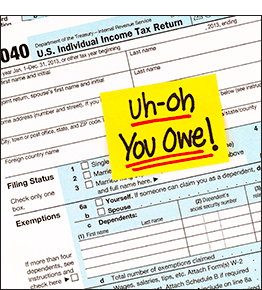In late 2020, the IRS announced that it will increase tax audits of small businesses by 50 percent in 2021. Here are several mistakes to avoid if you do get audited by Uncle Sam.
- Mistake: Missing income. A long history of investigating has led IRS auditors to focus on under-reported income. If you’re a business that handles cash, expect greater scrutiny from the IRS. The same is true if you generate miscellaneous income that’s reported to the IRS on 1099 forms. Be proactive by tracking and documenting all income from whatever source. Invoices, sales receipts, profit and loss statements, bank records—all can be used to substantiate income amounts.
- Mistake: Higher than normal business losses. Some small businesses struggle in the early years before becoming profitable. If your company’s bottom line never improves, the IRS may view your enterprise as a hobby and subsequently disallow certain deductions. As a general rule, you must earn a profit in three of the past five years to be considered a legitimate business.
 Mistake: Deductions lacking substantiation. Do you really use your home office exclusively for business? Does your company earn only $50,000 a year but claim charitable donations of $10,000? Do you write off auto expenses for your only car? The key to satisfying auditors is having clear and unequivocal documentation. They want source documents such as mileage logs that match the amount claimed on your tax return and clearly show a business purpose. If you can’t locate a specific record, look for alternative ways to support your tax return filings. In some cases, a vendor or landlord might have copies of pertinent records.
Mistake: Deductions lacking substantiation. Do you really use your home office exclusively for business? Does your company earn only $50,000 a year but claim charitable donations of $10,000? Do you write off auto expenses for your only car? The key to satisfying auditors is having clear and unequivocal documentation. They want source documents such as mileage logs that match the amount claimed on your tax return and clearly show a business purpose. If you can’t locate a specific record, look for alternative ways to support your tax return filings. In some cases, a vendor or landlord might have copies of pertinent records.- Mistake: No expense reports. If you use your credit card for business, create an expense report with account numbers and attach it to each statement. Then attach copies of the bills that support the charges. This is an easy place to blend in personal expenses with business expenses and auditors know it.
- Mistake: No separate books, bank accounts or statements. Never run personal expenses through business accounts and vice versa. Have separate bank accounts and credit cards. A sure sign of asking for trouble is not keeping the business separate from personal accounts and activities.
- Mistake: Treat the auditor as an enemy. Auditors have a job to do, and it’s in your best interest to make their task as painless as possible. Try to maintain an attitude of professional courtesy. If you’re called to their office, show up on time and dress professionally. If they come to your place of business, instruct staff to answer questions honestly and completely.
How to tell the difference
 Not all debt is created equal. Knowing the difference can change the way you look at your spending.
Not all debt is created equal. Knowing the difference can change the way you look at your spending.
Good debt adds value
Good debt often leads to financial growth, because the product or service being purchased adds more value than the debt that comes with it. Student loans are usually an example of good debt because the related education allows you to earn more income.
Some purchases result in value more directly. Taking on a mortgage, for example, can be valuable simply by giving you access to a place to live all while building equity. Additionally, a mortgage is often considered good debt because your property can be used as collateral for other debt once you’ve made some payments on it, or your home has gained in market value. Even better, good debt often comes with a tax deduction on the interest you pay on things like your mortgage or student loans.
Bad debt adds expense
Credit card debt is almost always bad debt. Not only are interest rates on credit cards higher than most other types of debt, but most purchases made with credit cards are for things that do not contribute to personal financial growth. In fact, interest expense is so high that credit card companies are now legally required to display the cost of this debt directly on their billing statements. Auto loans are another example of bad debt, because cars usually lose value quickly, often leaving more money owed on the debt than the car is worth! But even good debt can turn bad if there is too much of it. Take out too large a mortgage and you may struggle to make payments!
Debt always means higher cost
Debt’s big benefit is allowing you to pay for something over time. The cost of any purchase using debt MUST include the interest expense of taking on that debt. You can compare that with the option of saving up money and then making the purchase without interest. Is the extra interest worth the benefit? Comparing the cost of the purchase with interest, to the value you stand to gain by purchasing the asset, can help you determine whether using debt is a good or bad choice for you.
Final thoughts
Here are some ideas on how to manage good versus bad debt.
- Consider carefully what you can afford and make a plan for how you will pay off any debts before you take on the debt.
- Never carry a balance on a credit card unless it is an emergency. Pay the balance in full every month.
- Calculate the entire cost, including interest, of anything you purchase using debt. This is the REAL cost of an item.
- Use savings, whenever possible, to purchase goods and services that would otherwise be considered bad debt.
- Pay off high interest debt first.
- Financial growth is often the key measure for defining good versus bad debt, but not always. Other factors, like personal interest, growth, and well-being can also be measures for your debt decisions, as long as you can truly afford the payments.
Reach out for help if you aren’t confident whether a potential debt will be beneficial or harmful. Making the right choice could save you money.
 Understanding how our tax system works can be tricky for anyone. Whether you’re an adult who never paid much attention to the taxes being withheld from your paycheck or a kid who just got his or her first job, understanding the basics can help refine and define questions you may have.
Understanding how our tax system works can be tricky for anyone. Whether you’re an adult who never paid much attention to the taxes being withheld from your paycheck or a kid who just got his or her first job, understanding the basics can help refine and define questions you may have.
Many schools don’t teach these tax lessons. This results in many people entering life with a pretty incomplete picture of how taxes work, unless someone else takes the time to explain these tax concepts. Here are some pointers to help you or someone you know navigate our tax maze.
Taxes are mandatory!
While we can have a debate about how much each person should pay, there’s no debating that local, state and federal governments need tax revenue to run the country. These funds are used to build roads, support education, help those who need financial assistance, pay interest on our national debt and defend the country.
There are many types of taxes
When you think of taxes, most think of the income tax, which is a tax on business and personal income you earn from performing a job. But there are also other types of taxes. Here are some of the most common.
- Payroll taxes. While income taxes can be used to pay for pretty much anything the government needs money for, payroll taxes are earmarked to pay for Social Security and Medicare benefits.
- Property taxes. These are taxes levied on property you own. The most common example of this is the property tax on a home or vacation property.
- Sales tax. These are taxes placed on goods and services you purchase. While most of this tax is applied at the state and local levels, there are also federal sales taxes on items like gasoline.
- Capital gains taxes. If you sell an investment or an asset for a profit, you may owe capital gains taxes. The most common example of this is when you sell stock for a gain. Capital gains taxes could also come into play with other assets, such as a rental property you sell for a profit.
- Estate taxes. This tax is applied to assets in your estate after you pass away.
Not all income is subject to tax
Most, but not all, of your income is subject to tax.
- While your paycheck is subject to tax, interest earned from certain municipal bonds is not. And the government often excludes things like benefits from the tax man.
- Capital gains taxes have exclusions for gains on the sale of your home and donated stock.
- Estate taxes have an exclusion, so only estates in excess of the exclusion are taxed.
This is why having someone in the know can be really helpful in navigating these rules.
The progressive nature of income tax
When it comes to income taxes, the government gets to take the first bite. The question is how BIG of a bite the government gets to take.
For example, if you only have one chocolate chip cookie, the government’s bite is really, really small. If you have 1,000 chocolate chip cookies, the government takes a small bite from the first 100 cookies, a larger bite from the next 100 cookies, and an even larger bite from the remaining 800 cookies.
This is called a progressive tax rate system. For example, if you’re considered single for tax purposes in 2021, the first $9,950 of taxable money you earn gets taxed at 10%. The next $30,575 you earn gets taxed at 12%. The next $45,850 gets taxed at 22%. Money you earn above this point will get taxed at either 24%, 32%, 35% or 37%.
Understanding the progressive nature of our tax system is a key concept in managing the size of the bite the government takes. That is why tax planning is so important!
Deductions can decrease the government’s tax bite
The progressive tax system is complex because it is manipulated in a big way by our elected officials. This is typically done through credits, deductions and phaseouts of tax benefits.
For example, there is a fairly complex deduction for families with children, and the earned income tax credit is an added tax cut for those in the lower end of the progressive income tax base. There are also credits and deductions for businesses, homeowners, education and many more types of taxpayers.
As you can imagine, the U.S. tax system is very complex with many nuances. Please seek help if you have further questions or are facing a complicated taxable transaction.
 Don’t get shocked by a high tax bill! Be prepared for these pandemic-related tax surprises when you file your 2020 tax return. Please note: This information may change with ongoing legislation.
Don’t get shocked by a high tax bill! Be prepared for these pandemic-related tax surprises when you file your 2020 tax return. Please note: This information may change with ongoing legislation.
- Taxes on unemployment income. If you received unemployment benefits in 2020, you need to report these benefits on your tax return as taxable income. Check to see if either federal or state taxes were withheld from unemployment payments you received. If taxes were not withheld, you may need to write a check to the IRS when you file your tax return.
- Taxes from side jobs. Did you pick up a part-time gig to make ends meet? Payments received for performing these jobs may not have had your taxes withheld. If this is the case, you’ll need to pay your taxes directly to the IRS on April 15.
- Unusual profit-and-loss. If you run a business that was hit by the pandemic, you may find your estimated tax payments were either overpaid or underpaid compared to normal. Now that 2020 is in the books, run a quick projection to ensure you are not surprised with an unexpected tax bill when you file your tax return.
- Underpayment penalty. If you did not have proper tax withholdings from your paycheck or your estimated tax payments weren’t enough, you could be subject to an underpayment penalty. While it’s too late to avoid a penalty on your 2020 tax return, the solution in the future is to make high enough estimated tax payments each quarter in 2021 or have the appropriate amount withheld from your 2021 paychecks.
- A chance to claim missing stimulus payments. (A good surprise!) If any of your stimulus payments were for less than what you should have received, you can get money for the difference as a tax credit when you file your 2020 tax return.
Please use these examples to prepare yourself for a potential tax surprise during the uncertainty caused by the ongoing pandemic.
 No one likes surprises from the IRS, but they do occasionally happen. Here are some examples of unpleasant tax situations you could find yourself in and what to do about them.
No one likes surprises from the IRS, but they do occasionally happen. Here are some examples of unpleasant tax situations you could find yourself in and what to do about them.
- An expected refund turns into a tax payment. Nothing may be more deflating than expecting to get a nice tax refund and instead being met with the reality that you actually owe the IRS more money.
What you can do: Run an estimated tax return and see if you may be in for a surprise. If so, adjust how much federal income tax is withheld from your paycheck for the balance of the year. Consult with your company’s human resources department to figure out how to make the necessary adjustments for the future. If you’re self-employed, examine if you need to increase your estimated tax payments due in January, April, June and September.
- Getting a letter from the IRS. Official tax forms such as W-2s and 1099s are mailed to both you and the IRS. If the figures on your income tax return do not match those in the hands of the IRS, you will get a letter from the IRS saying that you’re being audited. These audits are now done by mail and are commonly known as correspondence audits. The IRS assumes their figures are correct and will demand payment for the taxes you owe on the amount of income you omitted on your tax return.
What you can do: Assuming you already know you received all your 1099s and W-2s and confirmed their accuracy, verify the information in the IRS letter with your records. Believe it or not, the IRS sometimes makes mistakes! It is always best to ask for help in how to correspond and make your payments in a timely fashion, if they are justified.
- Getting a tax bill for an emergency retirement distribution. Due to the pandemic, you can withdraw money from retirement accounts in 2020 without getting a 10% early withdrawal penalty, but you’ll still have to pay income taxes on the amount withdrawn. If you don’t plan for this extra tax you will be surprised with an additional tax bill. And you may still get an underpayment penalty bill from the IRS because you did not withhold enough during the year. You may also still receive an early withdrawal penalty in error because the IRS is still scrambling to update their systems with all of this year’s tax relief changes.
What you can do: Set aside a percentage of your distribution for taxes. Your account administrator may withhold funds automatically for you when you request the withdrawal, so check your statements. Your review should be for both federal and any state tax obligations. If the withholding is not sufficient, consider sending in an estimated tax payment. And if you are charged a withdrawal penalty, ask for help to correspond with the IRS to get this charge reversed.
No one likes surprises when filing their taxes. With a little planning now, you can reduce the chance of having a surprise hit your tax return later.
Find out if you owe the IRS an estimated tax payment
You may owe the IRS a tax payment for your 2020 tax return and not know it.
 Most Americans have income taxes withheld from their paychecks, with their employer sending a tax payment to the IRS on their behalf. This year, however, many more Americans will have to write Uncle Sam a check to pay a portion of their 2020 taxes on or before July 15. You may be one of these people!
Most Americans have income taxes withheld from their paychecks, with their employer sending a tax payment to the IRS on their behalf. This year, however, many more Americans will have to write Uncle Sam a check to pay a portion of their 2020 taxes on or before July 15. You may be one of these people!
Who needs to pay now!
You may need to make a payment if one of the following situations applies to you:
- Paychecks are under-withheld. Your employer withholds a portion of your paychecks for income tax purposes, then submits a payment to the IRS on your behalf. The amount that is withheld from your paychecks, however, may not cover your entire tax liability, resulting in you needing to write the IRS a check. If you’re not withholding enough, ask your employer to increase the withholding amount from your future paychecks so you don’t come up short again in the future.
- Unemployment compensation paychecks are under-withheld. Unemployment compensation is subject to federal income tax and subject to income taxes in several states. While some unemployment benefit checks withhold a percentage of your payment for income tax purposes, you may need to pay more in taxes than is being withheld.
- Self-employed workers. Unlike employees, self-employed workers don’t have income tax withheld from pay and must make four estimated tax payments over a period of 12 months. Self-employed workers include gig economy workers, freelancers, S corporation shareholders and partners in a partnership.
- Retirees. You may owe tax on Social Security benefits, as well as income from investments distributed to you or other unearned income. A portion of pension plan distributions may be withheld, but many times the amount withheld does not cover your entire tax liability, resulting in an underpayment.
- Sold a major asset. You may owe tax after selling an asset that results in a large capital gain, such as a house, or from the sale of securities.
- Receive alimony. If you’re being paid alimony under a divorce decree entered into before 2019, the payments constitute taxable income to you. Alimony from post-2018 agreements, however, are not taxable.
What you need to do
Estimate your total income for 2020, then calculate your total 2020 tax bill and divide it by 2. Compare this amount to how much has been withheld from your paychecks, unemployment benefits and any other payments you’ve made to the IRS. If you’re short, consider making an estimated payment by July 15 to make up the difference. This payment is made with Form 1040-ES.
If you do not make this payment on time, the IRS may impose a penalty plus interest on top of the underpaid taxes. Fortunately, you can avoid a penalty by paying at least 90% of the current year’s tax liability or 100% of the prior year’s tax liability (110% if your adjusted gross income for the prior year exceeds $150,000).
With summertime activities in full swing, tax planning is probably not on the top of your to-do list. But putting it off creates a problem at the end of the year when there’s little time for changes to take effect. If you take the time to plan now, you’ll have six months for your actions to make a difference on your 2019 tax return. Here are some ideas to get you started.
Know your upcoming tax breaks. Pull out your 2018 tax return and take a look at your income, deductions and credits. Ask yourself whether all these breaks will be available again this year. For example:
- Are you expecting more income that will bump you to a higher tax rate?
- Will increased income cause a benefit to phase out?
- Will any of your children outgrow a tax credit?
Any changes to your tax situation will make planning now much more important.
 Make tax-wise investment decisions. Have some loser stocks you were hoping would rebound? If the prospects for revival aren’t great, and you’ve owned them for less than one year (short-term), selling them now before they change to long-term stocks can offset up to $3,000 in ordinary income this year. Conversely, appreciated stocks held longer than one year may be candidates for potential charitable contributions or possible choices to optimize your taxes with proper planning.
Make tax-wise investment decisions. Have some loser stocks you were hoping would rebound? If the prospects for revival aren’t great, and you’ve owned them for less than one year (short-term), selling them now before they change to long-term stocks can offset up to $3,000 in ordinary income this year. Conversely, appreciated stocks held longer than one year may be candidates for potential charitable contributions or possible choices to optimize your taxes with proper planning.
Adjust your retirement plan contributions. Are you still making contributions based on last year’s limits? Maximum savings amounts increase for retirement plans in 2019. You can contribute up to $13,000 to a SIMPLE IRA, up to $19,000 to a 401(k) and up to $6,000 to a traditional or Roth IRA. Remember to add catch-up contributions if you’ll be 50 by the end of December!
Plan for upcoming college expenses. With the school year around the corner, understanding the various tax breaks for college expenses before you start doling out your cash for post-secondary education will ensure the maximum tax savings. There are two tax credits available, the American Opportunity Tax Credit (AOTC) and the Lifetime Learning Credit. Plus there are tax benefits for student loan interest and Coverdell Savings accounts. Add 529 college savings plans, and you quickly realize an educational tax strategy is best established early in the year.
Add some business to your summer vacation. If you own a business, you might be able to deduct some of your travel expenses as a business expense. To qualify, the primary reason for your trip must be business-related. Keep detailed records of where and when you work, plus get receipts for all ordinary and necessary expenses!
Great tax planning is a year-round process, but it’s especially effective at midyear. Making time now not only helps reduce your taxes, it puts you in control of your entire financial situation.
Ah, summer. The weather is warm, kids are out of school, and it’s time to think about tax saving opportunities! Here are five ways you can enjoy your normal summertime activities and save on taxes:
- Rent out your property tax-free. If you have a cabin, condo, or similar property, consider renting it out for two weeks. The rental income you receive on property rented for less than 15 days per year is not considered taxable income. In addition, you can still deduct your mortgage interest expense and property taxes in full as itemized deductions! Track the rental days closely — going over 14 days means all rent is taxable and rental income rules apply.
- Take a tax credit for summer childcare. For many working parents, the summer comes with the added challenge of finding care for their children. Thankfully, the Child and Dependent Care Credit can cover 20-35 percent of qualified childcare expenses for your children under the age of 13. Eligible types of care include day care, nanny fees and day camps (overnight camps and summer school do not qualify).
- Hire your kids. If you own a business, hire your kids. If you are a sole proprietor and your child is under age 18, you can pay them to work without withholding or paying Social Security and Medicare tax.
- Have a garage sale. In general, the money you make from a yard or garage sale is tax-free because you sell your goods for less than you originally paid for them. Once the sale is over, donate the remaining items to a qualified charity to get a potential charitable donation deduction. Just remember to keep a log of the items you donate and ask for a receipt.

- Start a Roth IRA for your children. Roth IRA contributions are limited to the amount of income your child earns, so earned income is key. This can include income from mowing lawns or selling lemonade. Start making contributions as soon as your child makes some money to take advantage of the tax-free earnings available in a Roth IRA.
Taking the time this summer to execute these tips can put extra money in your pocket right away and provide you tax-saving happiness in the future.
Couples consistently report finances as the leading cause of stress in their relationship. Here are a few tips to avoid conflict with your long-term partner or spouse:

Be transparent. Be honest with each other about your financial status. As you enter a committed relationship, each partner should learn about the status of the other person’s debts, income and assets. Any surprises down the road may feel like dishonesty and lead to conflict.
Discuss future plans often. The closer you are with your partner, the more you’ll want to know about the other person’s future plans. Kids, planned career changes, travel, hobbies, retirement expectations — all of these will depend upon money and shared resources. So, discuss these plans and create the financial roadmap to go with them. Remember that even people in a long-term marriage may be caught unaware if they fail to keep up communication and find out their spouse’s priorities have changed over time.
Know your comfort levels. As you discuss your future plans, bring up hypotheticals: How much debt is too much? What level of spending versus savings is acceptable? How much would you spend on a car, home or vacation? You may be surprised to learn that your assumptions about these things fall outside your partner’s comfort zone.
Divide responsibilities; combine forces. Try to divide financial tasks such as paying certain bills, updating a budget, contributing to savings and making appointments with tax and financial advisors. Then periodically trade responsibilities over time. Even if one person tends to be better at numbers, it’s best to have both members participating. By having a hand in budgeting, planning and spending decisions, you will be constantly reminded how what you are doing financially contributes to the strength of your relationship.
Learn to love compromise. No two people have the same priorities or personalities, so differences of opinion are going to happen. One person is going to want to spend, while the other wants to save. Vacation may be on your spouse’s mind, while you want to put money aside for a new car. By acknowledging that these differences of opinion will happen, you’ll be less frustrated when they do. Treat any problems as opportunities to negotiate and compromise. Instead of looking at the outcome as “I didn’t get everything I wanted,” think of it as “We both made sacrifices out of love for each other.”
 As the end of the year approaches, there is still time to make moves to manage your tax liability. Here are some ideas to consider.
As the end of the year approaches, there is still time to make moves to manage your tax liability. Here are some ideas to consider.
Maximize your retirement plan contributions. This includes traditional IRAs, Roth IRAs, and SEP IRAs for self-employed. Now is the time to maximize the contribution potential for this year and plan for next year’s contributions.
Estimate your current and next year taxable income. With this estimate you can determine which year receives the greatest benefit from a reduction in income. By understanding what the tax rate will be for your next dollar earned, you can understand the tax benefit of reducing income in this year versus next year.
Make charitable contributions. Consider which tax year will benefit most from your charitable giving of cash and non-cash items. Shift your giving into the year that will provide you the most benefit.
Take capital losses. Each year you can net capital losses against capital gains. You can also deduct up to $3,000 in excess losses against your other income. Start to identify which investments may make sense to sell to take advantage of this. If planned correctly, these losses can offset ordinary income.
Consider donating appreciated stock. This strategy gives you a charitable deduction for the market value of the stock, while not having to pay capital gains tax on the charitable gift. If you provide an annual pledge sheet to your church, this can be a great way to maximize your gift while giving needed funds to your church at the beginning of the year.
Retirement plan distributions. If you are age 70½ or older, take your required minimum distributions for the year. If you are retired, but younger than 70½, consider taking tax efficient distributions from your retirement accounts. By paying some tax now, you may avoid paying higher taxes later when you have to follow the minimum distribution rules.
Consider tax legislation. Please recall that tax laws passed in late 2016 made many temporary tax savings permanent and extended others into 2017. So save classroom related receipts if you are a teacher. Consider charitable contributions from your retirement plan if you are a senior. Keep receipts of large purchases to track a potential sales tax deduction.